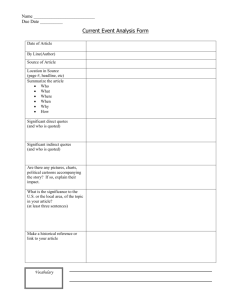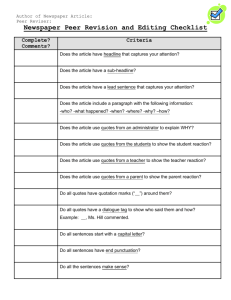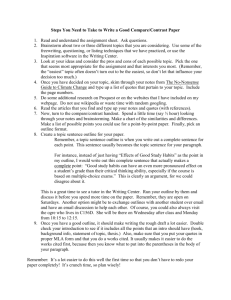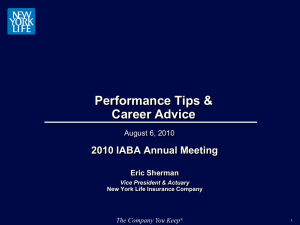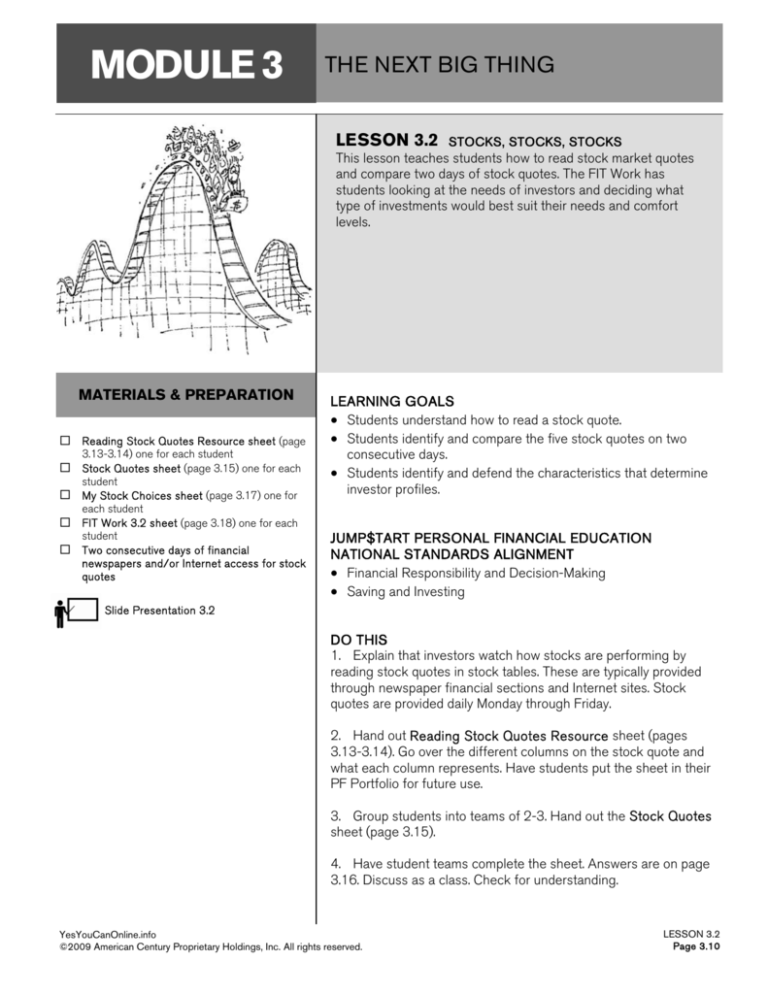
MODULE 3
THE NEXT BIG THING
LESSON 3.2
STOCKS, STOCKS, STOCKS
This lesson teaches students how to read stock market quotes
and compare two days of stock quotes. The FIT Work has
students looking at the needs of investors and deciding what
type of investments would best suit their needs and comfort
levels.
MATERIALS & PREPARATION
Reading Stock Quotes Resource sheet (page
3.13-3.14) one for each student
Stock Quotes sheet (page 3.15) one for each
student
My Stock Choices sheet (page 3.17) one for
LEARNING GOALS
Students understand how to read a stock quote.
Students identify and compare the five stock quotes on two
consecutive days.
Students identify and defend the characteristics that determine
investor profiles.
each student
FIT Work 3.2 sheet (page 3.18) one for each
student
Two consecutive days of financial
newspapers and/or Internet access for stock
quotes
JUMP$TART PERSONAL FINANCIAL EDUCATION
NATIONAL STANDARDS ALIGNMENT
Financial Responsibility and Decision-Making
Saving and Investing
Slide Presentation 3.2
DO THIS
1. Explain that investors watch how stocks are performing by
reading stock quotes in stock tables. These are typically provided
through newspaper financial sections and Internet sites. Stock
quotes are provided daily Monday through Friday.
2. Hand out Reading Stock Quotes Resource sheet (pages
3.13-3.14). Go over the different columns on the stock quote and
what each column represents. Have students put the sheet in their
PF Portfolio for future use.
3. Group students into teams of 2-3. Hand out the Stock Quotes
sheet (page 3.15).
4. Have student teams complete the sheet. Answers are on page
3.16. Discuss as a class. Check for understanding.
YesYouCanOnline.info
©2009 American Century Proprietary Holdings, Inc. All rights reserved.
LESSON 3.2
Page 3.10
MODULE 3
THE NEXT BIG THING
NOTES:
5. Have newspaper financial pages and/or Internet access
available so students can explore real stock quotes. Below is a list
of Web sites they could access:
Yahoo! – http://finance.yahoo.com
MSN – http://moneycentral.msn.com
Google – http://finance.google.com/finance
6. Hand out My Stock Choices (page 3.17) and have students
put it in their PF Portfolio. Explain to students they will need to
identify five companies and determine their ticker symbol (unique
alphabetic name that identifies the stock). They need to document
the “close” amount for today and tomorrow. The “close” is the
published trading price of a stock at the end of a trading day.
7. Challenge students to identify stocks that will increase in value
the most. Explain to students that My Stock Choices is a
competition and the top three students with the most improvement
of all five close values wins/is awarded something (i.e., lunch with
teacher, hall pass, get out of tardy token, missed homework pass,
candy, whatever motivates students).
8. After the second day, have students compare any changes with
the five stocks they selected. Determine the top winning students.
9. Discuss the changes and determine factors that could have
impacted the changes. For example, a drop in the economy,
declining unemployment, natural disaster, layoffs, increasing
number of bankruptcies, etc.
10. Optional: Have a representative from an investment institution
visit and discuss the stock market.
FIT WORK
ASSESSMENT
Optional: FIT Work 3.2 sheet (page 3.18). Students explore the
different types of investors and what types of investments would be
best for their situation. The answer key is on page 3.19
Observe and listen to discussions for logical thinking and
mastery of content.
Review Stock Quotes for completion and mastery.
Review My Stock Choices for completion and accurate recording
of information.
Review FIT Work 3.2 sheet for completion and mastery.
YesYouCanOnline.info
©2009 American Century Proprietary Holdings, Inc. All rights reserved.
LESSON 3.2
Page 3.11
MODULE 3
THE NEXT BIG THING
NOTES:
PFP
Reading Stock Quotes Resource (page 3.13-3.14)
Stock Quotes (page 3.15)
My Stock Choices (page 3.17)
FIT Work 3.2 sheet (page 3.18)
YesYouCanOnline.info
©2009 American Century Proprietary Holdings, Inc. All rights reserved.
LESSON 3.2
Page 3.12
Reading Stock Quotes Resource
Most financial papers and Web sites have stock quotes that look similar to the example below. Use
this sheet to learn how to read a stock quote table.
Sample stock quote table:
52W
High
52W
Low
$45.39
$19.75
Stock
Ticker
ResMed
RMD
11.63
3.55
Revlon A
REV
77.25
55.13
RioTinto
RTP
31.31
16.63
RitchieBr
RBA
8.44
1.75
RiteAid
RAD
38.63
18.81
RobtHalf
RHI
51.25
27.69
Rockwell
ROK
Col. 1
Col. 2
Col. 3
Col. 4
Div
P/E
YTD%
Chg
Vol
00s
High
Low
Close
Net
chg
52.5
-8.5
3831
42.00
39.51
41.50
-1.90
+1.3
162
6.09
5.90
6.09
+0.12
+5.5
168
72.75
71.84
72.74
+0.03
2.3
20.9
-2.4
15
24.49
24.29
24.49
-0.01
+3.9
31028
4.5
4.20
4.31
+0.21
26.5
+7.0
6517
27.15
26.50
26.50
+0.14
1.2
14.5
+5.4
6412
47.99
47.00
47.54
+0.24
Col. 5
Col. 6
Col. 7
Col. 8
Col. 10
Col. 11
Col. 12
Col. 9
Columns 1 and 2
52-Week High and Low – The highest and lowest prices the stock traded over the previous 52
weeks (one year) and typically does not include the previous day’s trading.
Column 3
Company Name and Type of Stock – The name of the company. If no special symbol or letter follows the name, it is common stock. Different symbols indicate different classes of shares (i.e., “pf”
means preferred stock).
Column 4
Ticker Symbol – The unique alphabetic name which identifies the stock. When looking for stock
quotes online, you search for a company by the ticker symbol. The following financial sites provide
the ticker symbols for companies.
Yahoo! – http://finance.yahoo.com
MSN – http://moneycentral.msn.com
Google – http://finance.google.com/finance
Column 5
Dividend Per Share – The estimate of the anticipated yearly dividend per share in dollars and
cents. If this space is blank, the company does not currently pay out dividends.
Column 6
Price/Earnings Ratio – Shows the relationship between a stock’s price and the company’s earnings for the last four quarters. Calculated by dividing the current price per share by the earnings per
share.
Column 7
Year-to-Date Percentage Change – Reports gain or loss in each stock’s price as a percentage of
its price on January 1.
YesYouCanOnline.info
©2009 American Century Proprietary Holdings, Inc. All rights reserved.
LESSON 3.2
Page 3.13
Reading Stock Quotes Resource
Column 8
Trading Volume – The total number of shares traded for the day (in hundreds). Add two zeros to
the end of the number listed to get the actual number traded.
Column 9 & 10
Day High and Low – The price range at which the stock has traded throughout the day. These are
the maximum and the minimum prices that people have paid for the stock.
Column 11
Close – The last trading price recorded when the market closed on the day. If the closing price is
up or down more than 5% than the previous day, the entire listing for that stock is bold-faced.
Column 12
Net Change – The change in the stock price from the previous day’s closing price in dollars. When
the net change is positive, it is recorded as being “up for the day.”
Quotes on the Internet
The most convenient way to get stock quotes is off the Internet. Most sites are updated frequently
and provide you more information, news, charting, and research tools.
Most public Internet sites that provide stock quotes are reporting the price with a 15-minute delay.
To get ‘real-time’ quotes typically requires a subscription to a fee-based service.
YesYouCanOnline.info
©2009 American Century Proprietary Holdings, Inc. All rights reserved.
LESSON 3.2
Page 3.14
Name
STOCK QUOTES
Date
Name
Close
Chg.
Div.
P/E
AT&T Inc
AlcatelLuc
Cisco
Citigroup
Comcast
ExxonMob
GenElec
Home Dep
Intel
IBM
JohnJn
LSI Corp
Microsft
Oracle
Pfizer
TimeWrn rs
VerizonCm
WalMart
25.20
1.86
16.77
2.53
13.64
68.10
10.11
23.56
15.03
96.89
52.60
3.04
18.37
18.07
13.62
19.30
30.20
52.10
+0.04
+0.08
+0.46
+.22
-0.01
-0.53
+0.18
+0.18
+0.31
+2.37
-0.41
-0.01
+0.89
+0.41
-0.08
+1.07
-0.02
+0.34
1.64
12
13
.04m
.27f
1.60
.40m
.90
.56
2.00
1.84
16
8
6
18
16
11
12
.52
.20
1.28
10
16
11
1.84
1.09f
13
15
YTD%
Chg.
High
52-wk
Low
-11.6
-13.5
+2.9
-62.3
-19.2
-14.7
-37.6
+2.3
+2.5
+15.1
-12.1
-7.6
-5.5
+1.9
-23.1
-13.5
-10.9
-7.1
40.70
7.76
27.72
27.35
22.86
96.12
38.52
30.74
25.29
130.93
72.76
7.87
32.10
23.62
21.60
37.47
39.94
63.85
20.90
1.09
13.61
.97
11.10
56.51
5.73
17.05
12.05
69.50
46.25
2.36
14.87
13.80
11.62
15.41
23.07
46.25
Answer the following questions by using the information in the stock quote table.
1. Which stock had the highest close value? What was the value?
2. Which stock had the most dramatic drop in close value from yesterday? How much?
3. Which stock had the highest value in the past 52 weeks? What was it?
4. Which stock had the highest loss this year? What was the percentage change?
5. How much of a dividend payment does Cisco pay out annually?
6. What is a price/earnings ratio? What company has the highest p/e?
YesYouCanOnline.info
©2009 American Century Proprietary Holdings, Inc. All rights reserved.
LESSON 3.2
Page 3.15
Name
STOCK QUOTES
Date
Name
Close
Chg.
Div.
P/E
AT&T Inc
AlcatelLuc
Cisco
Citigroup
Comcast
ExxonMob
GenElec
Home Dep
Intel
IBM
JohnJn
LSI Corp
Microsft
Oracle
Pfizer
TimeWrn rs
VerizonCm
WalMart
25.20
1.86
16.77
2.53
13.64
68.10
10.11
23.56
15.03
96.89
52.60
3.04
18.37
18.07
13.62
19.30
30.20
52.10
+0.04
+0.08
+0.46
+.22
-0.01
-0.53
+0.18
+0.18
+0.31
+2.37
-0.41
-0.01
+0.89
+0.41
-0.08
+1.07
-0.02
+0.34
1.64
12
13
.04m
.27f
1.60
.40m
.90
.56
2.00
1.84
16
8
6
18
16
11
12
.52
.20
1.28
10
16
11
1.84
1.09f
13
15
YTD%
Chg.
High
52-wk
Low
-11.6
-13.5
+2.9
-62.3
-19.2
-14.7
-37.6
+2.3
+2.5
+15.1
-12.1
-7.6
-5.5
+1.9
-23.1
-13.5
-10.9
-7.1
40.70
7.76
27.72
27.35
22.86
96.12
38.52
30.74
25.29
130.93
72.76
7.87
32.10
23.62
21.60
37.47
39.94
63.85
20.90
1.09
13.61
.97
11.10
56.51
5.73
17.05
12.05
69.50
46.25
2.36
14.87
13.80
11.62
15.41
23.07
46.25
Answer the following questions by using the information in the stock quote table.
1. Which stock had the highest close value? What was the value?
IBM, 96.89
2. Which stock had the most dramatic drop in close value from yesterday? How much?
ExxonMobil, -0.53
3. Which stock had the highest value in the past 52 weeks? What was it?
IBM, 130.93
4. Which stock had the highest loss this year? What was the percentage change?
Citigroup, -62.3%
5. How much of a dividend payment does Cisco pay out annually?
It does not make dividend payments.
6. What is a price/earnings ratio? What company has the highest p/e?
It is the relationship between a stock’s price and the company’s earnings for the last four
quarters. Home Depot had the highest p/e.
YesYouCanOnline.info
©2009 American Century Proprietary Holdings, Inc. All rights reserved.
LESSON 3.2
Page 3.16
Name
MY STOCK CHOICES
Date
Complete the table with the appropriate information from the stocks you plan to track.
Company Name
Ticker
Symbol
Rationale for Choosing
Document and graph the “Close” amount for each stock over a two-day period.
Ticker
Symbol
Day 1 Close
Day 2 Close
+/−
Total +/−
Overall, how did the value of your stocks change over the 24-hour time period?
What factors do you think caused the price to change?
YesYouCanOnline.info
©2009 American Century Proprietary Holdings, Inc. All rights reserved.
LESSON 3.2
Page 3.17
FIT Work 3.2
Name
Date
All investments have associated risks. It’s important to determine the level of risk investors are
prepared to accept because this affects investment strategy. Generally, the higher the level of
risk an investor is prepared to accept, the higher the potential return from the investment. On the
other hand, a higher level of risk also increases the chance of incurring a loss in the short term,
including the potential loss of some of the initial investment amount.
Below are five different investor profiles:
Very Conservative – seeks to maintain the original value of the investments and is
prepared to accept lower returns for lower risk.
Conservative – seeks relatively stable returns and accepts some risk through a diversified
portfolio.
Moderate – seeks higher medium-term returns and accepts the possibility of negative
returns over short periods.
Aggressive – seeks high long-term returns and accepts the higher possibility of sustained
negative returns over short periods.
Very Aggressive – seeks to maximize long-term returns and accepts the possibility of
greater volatility and short-term capital losses.
Assign a profile for the following investors based on the types of investments they have made.
Explain why you assigned that profile.
Laura’s investments are mainly in bonds, and also in her house.
Brenda’s investments are all in stock shares and real estate.
Jennifer’s investments are in mutual funds, real estate, and she holds stock shares in her
company.
YesYouCanOnline.info
©2009 American Century Proprietary Holdings, Inc. All rights reserved.
LESSON 3.2
Page 3.18
FIT Work 3.2
Name
Date
All investments have associated risks. It’s important to determine the level of risk investors are
prepared to accept because this affects investment strategy. Generally, the higher the level of
risk an investor is prepared to accept, the higher the potential return from the investment. On the
other hand, a higher level of risk also increases the chance of incurring a loss in the short term,
including the potential loss of some of the initial investment amount.
Below are five different investor profiles:
Very Conservative – seeks to maintain the original value of the investments and is
prepared to accept lower returns for lower risk.
Conservative – seeks relatively stable returns and accepts some risk through a diversified
portfolio.
Moderate – seeks higher medium-term returns and accepts the possibility of negative
returns over short periods.
Aggressive – seeks high long-term returns and accepts the higher possibility of sustained
negative returns over short periods.
Very Aggressive – seeks to maximize long-term returns and accepts the possibility of
greater volatility and short-term capital losses.
Assign a profile for the following investors based on the types of investments they have made.
Explain why you assigned that profile.
Laura’s investments are mainly in bonds, and also in her house.
This is a Very Conservative profile. Bonds are low-risk, low-interest investments and
equity on a home does not pay any interest but is considered a good and safe
investment.
Brenda’s investments are all in stock shares and real estate.
Having all investments in stocks and real estate constitutes a Very Aggressive profile.
Stocks and real estate are long-term investments that can have big gains but both of
these markets are highly volatile.
Jennifer’s investments are in mutual funds, real estate, and she holds stock shares in her
company.
This mix of investments point to a Moderate profile. While there is some aggressive
investments in real estate and stocks, the portfolio is tempered by the mutual funds.
YesYouCanOnline.info
©2009 American Century Proprietary Holdings, Inc. All rights reserved.
LESSON 3.2
Page 3.19


